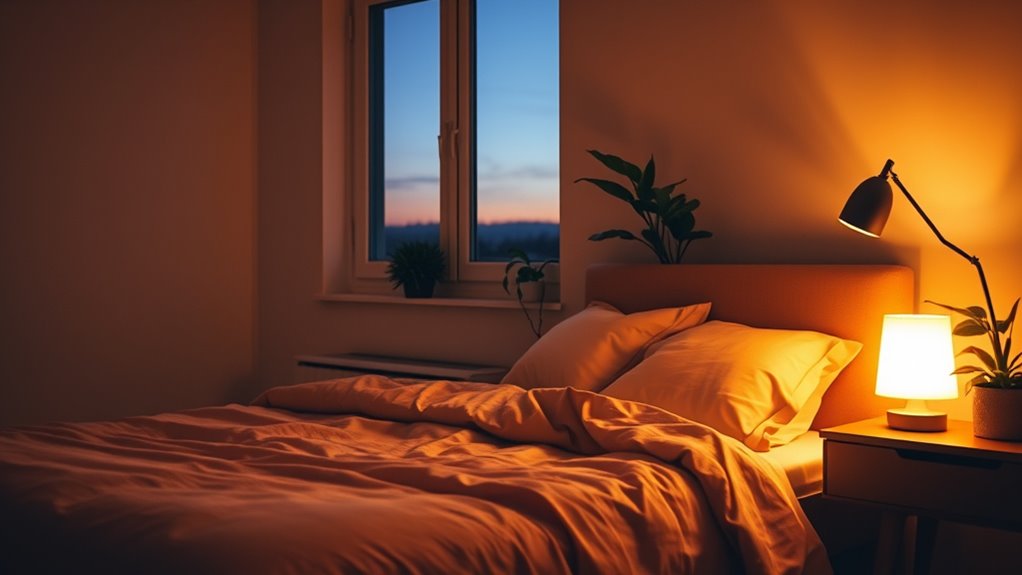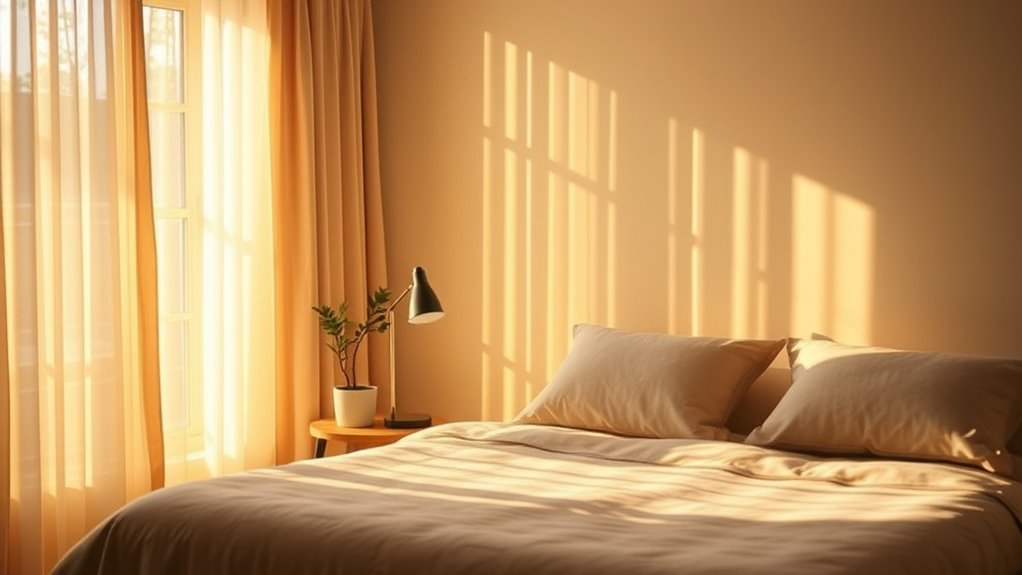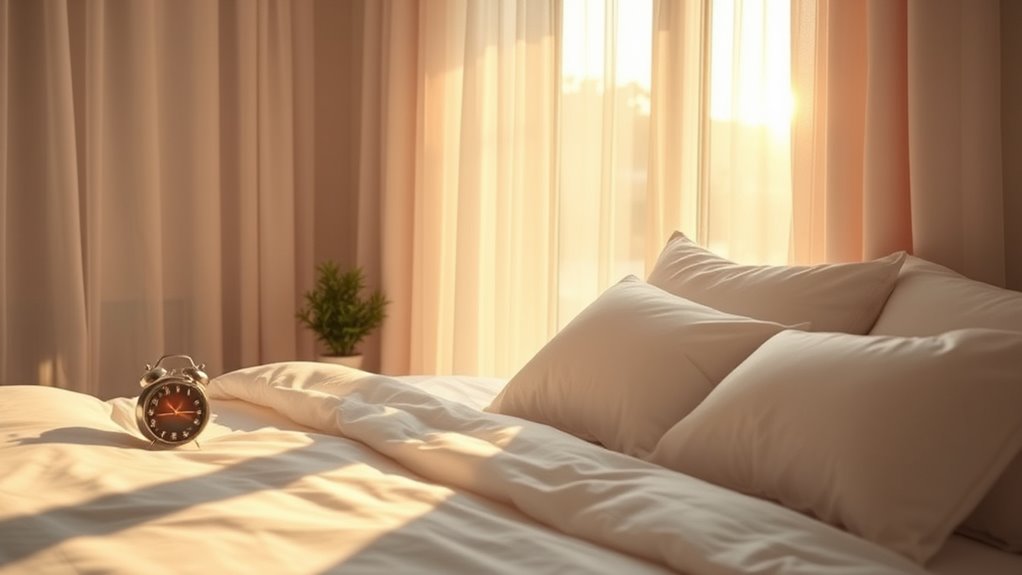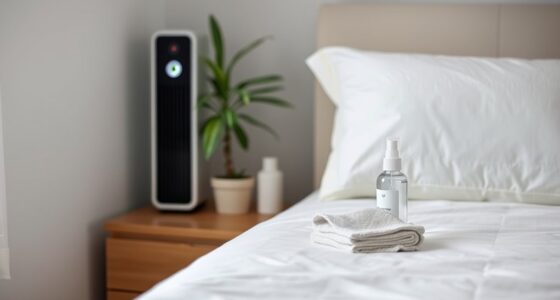Your internal clock, the circadian rhythm, controls your sleep-wake cycle by responding to natural light and darkness. Exposure to sunlight in the morning boosts alertness, while darkness signals your body to prepare for sleep through melatonin production. Disruptions like irregular schedules or artificial blue light can throw this rhythm off, affecting your health and home comfort. Keep exploring to discover simple ways to support and harmonize your daily routine with your natural biology.
Key Takeaways
- Your internal clock regulates sleep and alertness, aligning your body’s functions with a 24-hour cycle.
- Light exposure, especially in the morning, helps reset your circadian rhythm and boosts daytime energy.
- Darkness triggers melatonin production, signaling your body it’s time to rest, while artificial light can delay sleep.
- Disrupting your natural rhythm through shift work or irregular schedules can negatively impact health and sleep quality.
- Consistent routines, proper light exposure, and limiting screen time before bed support a balanced circadian cycle.
Understanding Your Internal Clock: The Science Behind Circadian Rhythms

Your internal clock, known as the circadian rhythm, is a natural, internal process that regulates your sleep-wake cycle. It operates through biological mechanisms that coordinate various bodily functions, ensuring you feel alert or sleepy at the right times. Central to this system is hormonal regulation; hormones like melatonin and cortisol fluctuate in response to your biological clock. Melatonin increases in the evening, signaling your body to prepare for sleep, while cortisol rises in the morning to boost alertness. These hormonal changes are driven by complex biological mechanisms that respond to internal cues and help synchronize your body’s activities with the 24-hour day. Understanding these processes helps explain why your body naturally follows a daily rhythm, even without external influences.
How Light and Darkness Influence Your Daily Cycle

Light and darkness are powerful external cues that help regulate your circadian rhythm by signaling when to wake and sleep. Your body responds to light exposure by suppressing melatonin, the sleep hormone, making you feel alert and awake. Conversely, darkness cues trigger melatonin production, encouraging sleep. Natural light in the morning resets your internal clock, promoting alertness during the day. As darkness falls, reduced light exposure signals your body to prepare for rest. Artificial light, especially blue light from screens, can interfere with these cues, delaying melatonin release and disrupting your cycle. To support healthy rhythms, get ample daylight during the day and minimize light exposure before bed. This balance helps regulate your sleep-wake cycle naturally and improves overall wellness.
The Impact of Circadian Disruption on Your Health and Home Environment

When circadian disruption occurs, it can markedly impair both your physical health and the environment of your home. Shift work, especially night shifts, forces your body to operate against its natural rhythm, increasing risks of sleep problems, heart disease, and weakened immunity. Jet lag, caused by rapid travel across time zones, throws off your internal clock, leading to fatigue, mental fog, and digestive issues. These disruptions can also affect your home environment by reducing your sleep quality and increasing stress levels. Constantly battling your internal clock makes it harder to relax and maintain healthy routines. Over time, this imbalance can diminish your overall wellness, making it essential to understand how circadian disruption impacts both your body and your living space.
Simple Adjustments to Sync Your Routine With Your Natural Rhythm

Adjusting your daily habits can help align your internal clock with your natural circadian rhythm. Start by establishing consistent bedtime routines, such as winding down with calming activities and going to bed at the same time each night. This consistency signals your body that it’s time to sleep and helps regulate your internal clock. Additionally, prioritize morning sunlight exposure; stepping outside for a few minutes each morning boosts your alertness and reinforces your circadian cues. Avoid bright screens before bed, which can interfere with melatonin production. Small changes like these make a significant difference in syncing your routines with your natural rhythm, leading to better sleep quality, increased energy, and improved overall wellness.
The Role of Sleep, Diet, and Exercise in Maintaining Balance

Maintaining a healthy balance in sleep, diet, and exercise is essential for supporting your circadian rhythm and overall well-being. Consistent sleep schedules help regulate your internal clock, while meal timing influences your energy levels and digestion. Eating at regular times, especially avoiding late-night meals, aligns with natural rhythms. Staying hydrated is equally important; proper hydration habits support bodily functions and prevent fatigue. Incorporate light exercise into your daily routine to boost your mood and sleep quality, but avoid intense workouts close to bedtime. By syncing your habits with your circadian cycle, you’ll improve energy, mood, and overall health. Remember, small adjustments like meal timing and hydration habits can make a significant difference in maintaining balance and supporting your body’s natural rhythm.
Tips for Creating a Home Space That Supports Your Circadian Well-being

Creating a home environment that supports your circadian well-being starts with optimizing your lighting. Use warm, dim lights in the evening to mimic sunset, and maximize natural light during the day to reinforce your body’s internal clock. Incorporate calming home decor that promotes relaxation, such as soft textiles and earthy tones. Scent therapy with lavender or chamomile can enhance your sleep environment and reduce stress. Consider blackout curtains for sleeping areas to block out unwanted light. Incorporate adjustable lighting options to control brightness levels easily. Use natural materials and soothing colors to create a restful atmosphere. These small adjustments help your home support your circadian rhythm, making it easier to wind down and wake up refreshed.
Frequently Asked Questions
How Can I Tell if My Circadian Rhythm Is Out of Sync?
You can tell your circadian rhythm is out of sync if you often experience sleep deprivation, feeling tired even after a full night’s sleep, or struggle to fall asleep at night and wake up feeling unrefreshed. Jet lag symptoms like fatigue, irritability, or difficulty concentrating also indicate your internal clock is off. Pay attention to these signs, and consider adjusting your sleep schedule to restore harmony with your natural rhythm.
Are There Specific Foods That Naturally Enhance My Internal Clock?
Yes, certain foods can naturally support your internal clock. Sleep-promoting foods like cherries, almonds, and warm milk provide tryptophan and melatonin, helping you fall asleep faster. Nutrient timing matters too—eat these foods earlier in the evening to align with your circadian rhythm. Avoid heavy, processed meals late at night, as they can disrupt your sleep. Incorporate these foods into your routine to help keep your internal clock steady and your sleep quality high.
Can Medications Affect My Circadian Rhythm and Sleep Quality?
Yes, medications can affect your circadian rhythm and sleep quality. Sleep medications, in particular, might help you fall asleep faster but can also cause side effects like grogginess or disrupted sleep cycles over time. Other medications, such as certain antidepressants or stimulants, may interfere with your internal clock, making it harder to maintain consistent sleep patterns. Always consult your doctor about potential side effects and how medications might impact your sleep health.
How Does Age Influence My Circadian Patterns and Home Environment Needs?
As you age, your sleep patterns naturally change due to age-related sleep changes, often leading to earlier wake times and lighter sleep. To support your circadian rhythm, you should make home environment adjustments like ensuring morning sunlight exposure, reducing evening light, and maintaining a cool, dark, quiet bedroom. These steps help regulate your sleep-wake cycle and improve overall sleep quality as you age.
What Are Signs of Long-Term Circadian Disruption I Should Watch For?
Imagine your body as a finely tuned orchestra, and long-term circadian disruption throws the instruments out of sync. You might notice persistent sleep disturbances, like falling asleep or staying asleep issues, and daytime fatigue. Hormonal imbalances can cause mood swings, weight changes, or decreased immunity. If these signs linger, it’s a red flag that your circadian rhythm’s harmony is broken, and you should seek ways to restore your internal clock.
Conclusion
By tuning into your body’s natural clock, you can truly make the most of your days. Small changes like managing light exposure, prioritizing sleep, and creating a cozy, balanced home environment can keep your rhythm steady. Remember, when you’re in sync with your circadian cycle, you’re more likely to feel on top of the world. It’s the secret sauce that helps you stay healthy, energetic, and ready to face whatever comes your way.








